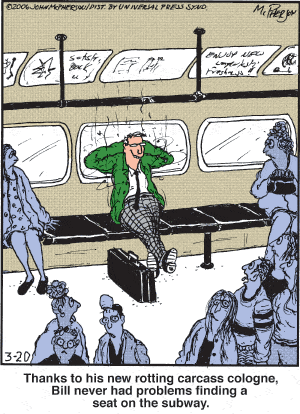When maximizing mobility isn't the question, parking is often the first answer offered
 Close to Home cartoon, 3/20/2006.
Close to Home cartoon, 3/20/2006.There is an e-discussion on the columbia_heights yahoogroup about parking, sparked by the Washington Times article "Teachers struggle to find parking." Of course, my point is that schools and churches and similar institutions should (1) have to produce, maintain, and make available to the public "transportation demand management" plans; (2) that "free parking" shouldn't be provided to employees as a matter of course; (3) that ANCs should create transportation committees to address such issues, etc.
According to the article, the relevant ANC suggests that teachers get special parking permits. Instead, why not have the teachers take transit to work?
However, in one of my posts I mentioned how some communities, such as Bethesda, have "parking management districts," and I've mentioned that before in the blog. But I realize that is far too limiting, because the issue is mobility and transportation, and focusing energies on "parking" will mean that producing more parking will be the inexorable solution.
I have said before that I don't think that DC's "Strategic Neighborhood Action Plans" are neighborhood plans. This is another example. Neighborhoods need, as part of a comprehensive neighborhood plan, a transportation-mobility element.
One of the people mentioned that transit should be improved but that roads should be widened and parking structures built. The latter two suggestions are suburban solutions that aren't appropriate if maintaining urban-ness is a primary objective of urban planning for the center city.
Today's Chicago Sun-Times has an article, "Web site marks the spots for city drivers," about how the Parking Industry Labor Management Council of Chicago has created a master website that shows what parking structures are close to the intended destination of the user. This is one, but only one aspect of a "comprehensive mobility plan" that could be created.
While I don't like the idea of "inducing" driving demand, this is a useful service and it also goes a long way towards coordinating the provision of parking. Coordinated management of parking sources downtown doesn't occur. You see this if you are in the vicinity of "Verizon Arena," and watch drivers pull into an office building lot only to be turned away.
The Chicago website is www.ChicagoParkingMap.com.
________
Cheryl Cort of Washington Regional Network just sent this email, which is worth repeating:
Give teachers before-tax transit benefits:
The first thing to do to improve teacher's commutes is to get them the same DC employee benefit of before-tax transit benefits that the rest of DC workers have. The DCPS needs to act on this.
The second is to have every school develop a "transportation management plan" in order to maximize potential for transit, bike & walk access.
Perhaps transit subsidies could be financed from parking charges if parking is offered to teachers. But play spaces at schools should not be used for teacher parking. This seems to happen frequently, but I don't think it's an official policy to take away play space and give it to parking.
Index Keywords: mobility; parking



0 Comments:
Post a Comment
<< Home